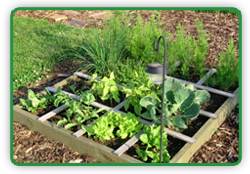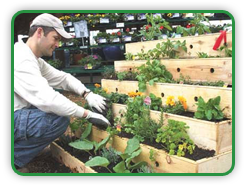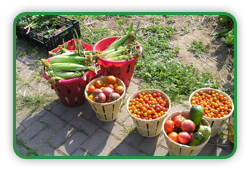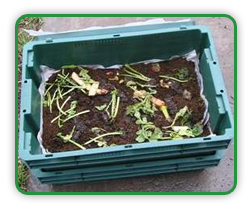|
Home > Guides > Urban Gardening > Square Foot Gardening > Maximum Yield Garden |
|
Maximum Yield Garden |
Efficient  Small Scale Small Scale  Limited Space Limited Space |
It is little secret that an overwhelming proportion of the food we consume on a daily basis is grown in rural areas. These locations offer an abundance of space and natural sunlight, which facilitates the rapid growth and maturation of the vast majority of common edibles. Urban areas, on the other hand, are generally not considered ideal environments for the cultivation of edible fruits and vegetables because of the small space available. Such environments have limited space, are dominated by concrete and glass rather than soil, and setting up spaces devoted to growing edible plants requires careful planning in making the most of every available square foot to get the maximum yield possible.
|
 |
|
|
| |
|
|
| |
|
|
| |
Square Foot Gardening
 Despite the obstacles to gardening in confined spaces, increasing numbers of city dwellers and suburbanites are looking for ways to produce their own food. Whether borne of curiosity, necessity, or a desire to be more active in providing sustenance for themselves or their families, such individuals are discovering a new source of power and self-sufficiency in growing food. No longer dependant on large-scale commercial agriculture, they are learning practical skills that are sure to enrich their well-being for years to come. Despite the obstacles to gardening in confined spaces, increasing numbers of city dwellers and suburbanites are looking for ways to produce their own food. Whether borne of curiosity, necessity, or a desire to be more active in providing sustenance for themselves or their families, such individuals are discovering a new source of power and self-sufficiency in growing food. No longer dependant on large-scale commercial agriculture, they are learning practical skills that are sure to enrich their well-being for years to come.
 Fortunately, there are more resources available than ever to the space-conscious home gardener looking to become more responsible for the food they eat. Authors and teachers such as Jon Jeavons, Mel Bartholomew, Rosalind Creasy and others have devised thoughtful and often ingenious new techniques to make the most of limited space, soil, and sunlight and other resources in urban settings. In addition, a pioneering wave of home and indoor gardeners have done much to advance the science of hydroponics, or soil-less growing techniques, in the last several decades. Fortunately, there are more resources available than ever to the space-conscious home gardener looking to become more responsible for the food they eat. Authors and teachers such as Jon Jeavons, Mel Bartholomew, Rosalind Creasy and others have devised thoughtful and often ingenious new techniques to make the most of limited space, soil, and sunlight and other resources in urban settings. In addition, a pioneering wave of home and indoor gardeners have done much to advance the science of hydroponics, or soil-less growing techniques, in the last several decades.
|
| |
|
|
|
| |
|
|
|
|
Maximum Yield Garden
 Obtaining maximum yields with minimum effort is an obvious credo of anyone who has ever worked the soil for edible vegetables, fruits or grains. It should be noted that for truly maximum yield, we must consider not only the quantity of fruits and vegetables cultivated, but also the quality of those products. Fortunately, understanding of techniques that both nourish us and enrich the soil we grow our food in has flourished over the last few decades with the organic food movement and continued development of natural farming philosophies such as permaculture. Such developments have slowly but surely started to transform how we see our food and the true cost of convenience in agriculture and the supply chain. Obtaining maximum yields with minimum effort is an obvious credo of anyone who has ever worked the soil for edible vegetables, fruits or grains. It should be noted that for truly maximum yield, we must consider not only the quantity of fruits and vegetables cultivated, but also the quality of those products. Fortunately, understanding of techniques that both nourish us and enrich the soil we grow our food in has flourished over the last few decades with the organic food movement and continued development of natural farming philosophies such as permaculture. Such developments have slowly but surely started to transform how we see our food and the true cost of convenience in agriculture and the supply chain.
 There is rapidly developing a realization that food grown on barren, depleted soil will exhibit those same barren, depleted tendencies on the dinner plate. For ideal health, we require a wide assortment of minerals and other nutrients that are conspicuously absent from many commercially grown fruits and vegetables. With some effort and patience, we can grow our crops in nutrient dense growing medium that we have actively created. Home worm bins and amending soil annually with compost and other organic constituents can go a long ways to ensuring strong, fertile soil and harvest that is both bountiful and chock-full of essential nutrition. There is rapidly developing a realization that food grown on barren, depleted soil will exhibit those same barren, depleted tendencies on the dinner plate. For ideal health, we require a wide assortment of minerals and other nutrients that are conspicuously absent from many commercially grown fruits and vegetables. With some effort and patience, we can grow our crops in nutrient dense growing medium that we have actively created. Home worm bins and amending soil annually with compost and other organic constituents can go a long ways to ensuring strong, fertile soil and harvest that is both bountiful and chock-full of essential nutrition.
|
|